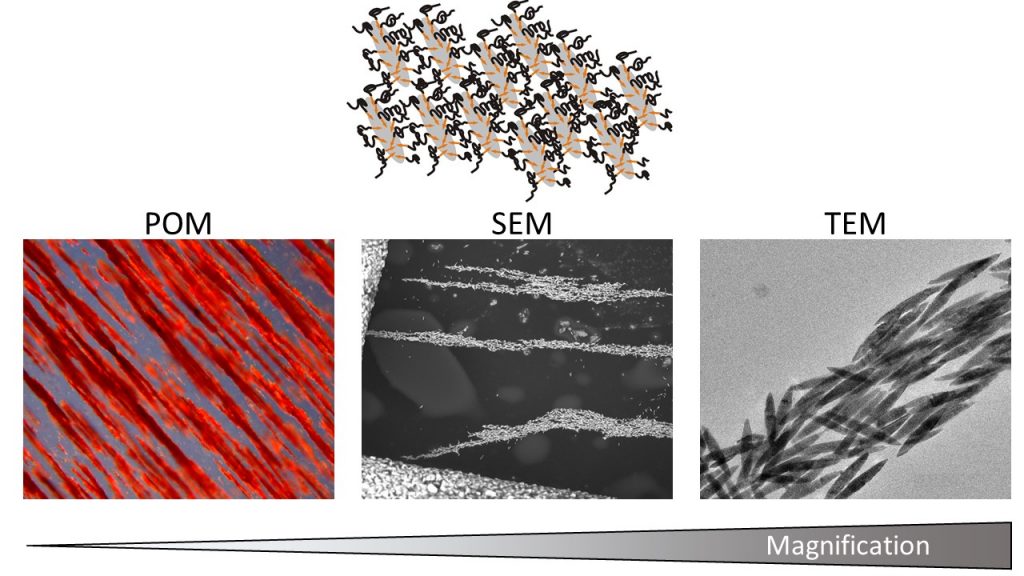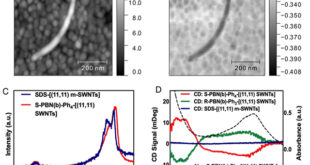Significance
New responsive materials require often the combination of properties typical for inorganic or organic materials in an organized structure. In this context, it gets e.g. possible to prepare magneto-responsive liquid crystalline phases by combining magnetic, shape anisotropic inorganic nanoparticles with block copolymers to form lyotropic (mineral) liquid crystals.
Mineral liquid crystals from ionically stabilized inorganic nanoparticles have been known for a long time. In general, the formation of lyotropic liquid crystals from rigid-rod objects as a result of anisotropy in form is well understood. Several lyotropic liquid crystalline phases have been investigated for various rigid-rod objects, for example, tobacco mosaic viruses, V2O5 ribbons, and semiconducting nanorods such as CdTe, ZnO and TiO2. They can be stabilized through charge and steric stabilization. Ion free mineral liquid crystals from uncharged anisotropic nanoparticles in organic solvents are necessary for implementation in electronic devices. For the case of steric stabilization, the nanoparticles need to be surface functionalized with a soluble corona. This is in a bid to overcome the strong adhesion forces between them and to enable dispersibility in the solvent.
While many types of anisotropic in form nanoparticles have been used for the preparation of lyotropic liquid crystal phases, there are only a few examples implementing anisotropic in form Fe3O4 nanoparticles as mesogens. This is, however, surprising as the use of magnetic nanoparticles as building blocks for the liquid crystalline phase would make it responsive to external magnetic fields. In addition, the application of an external magnetic field would magnetize the nanoparticles adding extra attractive interactions between them, apart from the anisotropic repulsive forces of the rod-like objects. This would stabilize the liquid crystalline phase.
Researchers led by Professor Rudolf Zentel at Johannes Gutenberg University in Germany successfully demonstrated the surface functionalization of anisotropic in form magnetic Fe3O4 nanorods with poly(methyl methacrylate) and hydrophilic poly((diethylene glycol monomethyl ether)methacrylate) block copolymers. Their research work is published in Journal of Materials Chemistry C.
The research team chose highly magnetic nanorods in order to get stronger response in the hybrid system. They characterized the surface functionalization of nanorods and then investigated the formation of liquid crystalline phases in highly concentrated solutions, whereby the anisotropic in form nanorods acted directly as mesogens. The authors also observed their behavior under an external magnetic field.
The polymers were prepared though RAFT polymerization. The authors performed a successful surface functionalized though a grafting-to method and monitored it through thermogravimetric analysis, infrared spectroscopy and transmission electron microscopy. The nanorods functionalized with polymer exhibited a high dispersibility in organic solvents. During solvent evaporation, birefringent domains were created. The authors could observe the self-assembly into lyotropic structures in polyethylene glycol 400 acting as a non-evaporating solvent.
Anisotropic in form nanorods aligned themselves along a director without mobility loss. Magnetic fields were observed to have strong effects on the liquid crystal phases developed. They did not only lead to macroscopic orientation, but also led to phase separation into concentrated liquid crystal phases and an isotropic phase, majorly free of nanorods. This self-assembly is not reversible, as the liquid crystalline structures remained after the magnetic field was removed. However, the authors could reverse this alignment by demagnetizing the nanoparticles. The authors also investigated hydrophilic poly((diethylene glycol monomethyl ether)methacrylate)-functionalized nanorods in excess polymer acting as “solvent” and liquid crystalline phases were also observed.

Reference
B. Klöckner, P. Daniel, M. Brehmer, W. Tremel and R. Zentel, Liquid crystalline phases from polymer functionalized ferri-magnetic Fe3O4 nanorods, Journal of Materials Chemistry C, Issue 5 (2017), pages 6688—6696, DOI: 10.1039/c7tc01106g.
Go To Journal of Materials Chemistry C
 Advances in Engineering Advances in Engineering features breaking research judged by Advances in Engineering advisory team to be of key importance in the Engineering field. Papers are selected from over 10,000 published each week from most peer reviewed journals.
Advances in Engineering Advances in Engineering features breaking research judged by Advances in Engineering advisory team to be of key importance in the Engineering field. Papers are selected from over 10,000 published each week from most peer reviewed journals.



